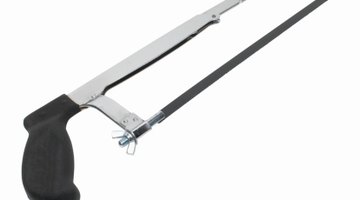Wire Cutter Substitutes
Though wire cutters (pliers with sharp side jaws) are very efficient in cutting through different types of wires, you can use other substitute tools to carry out the process in a quick and easy fashion. If they are not already in your tool bag, you can find all tools mentioned here from major DIY stores.

Though wire cutters (pliers with sharp side jaws) are very efficient in cutting through different types of wires, you can use other substitute tools to carry out the process in a quick and easy fashion. If they are not already in your tool bag, you can find all tools mentioned here from major DIY stores.
Hacksaw
A hacksaw has a thin metal blade roughly 12 inches long, supported on each end by a metal frame. You can buy blades with different TPI (teeth per inch), with the higher TPI being better to cut through wire; 18, 24 and 36 TPI are common saw blade sizes. Holding the hacksaw's handle, rest its blade at a 90-degree angle across the wire, and move the hacksaw backward and forward until it fully cuts through the wire.
Tin snips
Tin snips has two sharp blades, with handles roughly 8 inches long. Designed originally to cut through thin sheets of metal, the snips can slice through softer wire such as copper. Open the tin snips' handles, and position the wire between its blades. Close the handles to cut through the wire.
Angle Grinder
An angle grinder is an electric tool that rotates a circular disk-shaped metal-cutting blade at high revolutions. You also can attach circular brushes clean metal surfaces. Wearing eye goggles, turn on the grinder and hold the rotating blade against the wire. Move the blade slowly against the wire until you cut through. This tool works well when cutting through larger-gauge wires that regular wire cutters are too small to handle.
Reciprocating Saw
Also an electric tool, a reciprocating saw has a long thin blade (different lengths available) attached to its end that moves forwards and backwards at high speeds. Craftsmen generally use it to cut through materials (wood, pipes) in spaces where other saws do not fit. However, with a metal-cutting blade that has a high TPI number, you can easily cut through all types of wire. Turn on the reciprocating saw, and slowly lower the moving blade against the wire. Push the blade against the wire until you cut through. Wear eye goggles. Like the angle grinder, this saw also cuts through larger-gauge wires.
The Drip Cap
- Though wire cutters (pliers with sharp side jaws) are very efficient in cutting through different types of wires, you can use other substitute tools to carry out the process in a quick and easy fashion.
- You also can attach circular brushes clean metal surfaces.
- Turn on the reciprocating saw, and slowly lower the moving blade against the wire.
- Push the blade against the wire until you cut through.
References
- Ultimate Handyman: Cutting Metal
- "Home Improvement 1-2-3"; Benjamin W. Allen, Christopher Cavanaugh; 1995
Resources
Writer Bio
Steve Sloane started working as a freelance writer in 2007. He has written articles for various websites, using more than a decade of DIY experience to cover mostly construction-related topics. He also writes movie reviews for Inland SoCal. Sloane holds a Bachelor of Arts in creative writing and film theory from the University of California, Riverside.
Photo Credits
- George Doyle/Stockbyte/Getty Images
- George Doyle/Stockbyte/Getty Images
More Articles



